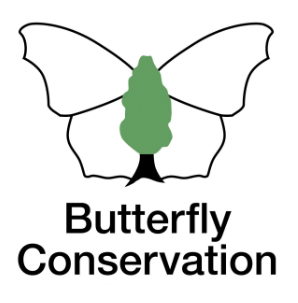Brown Argus
Brown Hairstreak
Chalkhill Blue
Clouded Yellow
Comma
Common Blue
Dark Green Fritillary
Dingy Skipper
Essex Skipper
Gatekeeper
Green Hairstreak
Green-veined White
Grizzled Skipper
Holly Blue
Large Skipper
Large White
Marbled White
Meadow Brown
Orange-tip
Painted Lady
Peacock
Purple Emperor
Purple Hairstreak
Red Admiral
Ringlet
Silver-washed Fritillary
Small Blue
Small Copper
Small Heath
Small Skipper
Small Tortoiseshell
Small White
Speckled Wood
Wall
White Admiral
White-letter Hairstreak
Extinct/rare immigrants
Small Skipper
Thymelicus sylvestris
General Distribution and Status
The Small Skipper is widespread and common in England and Wales. It is slowly expanding northwards and reached east Scotland south of the River Tay since the turn of the century. There has been a significant decline in numbers since 1976 and 2024 was the worst year on record. In Hertfordshire and Middlesex, numbers have also fallen quite dramatically and the species now appears to have disappeared in many parts of north-east Hertfordshire (Wood, 2020). It is possible that more Essex Skippers are counted instead as more observers are aware of the differences between the two species. Another possible reason for the fall in numbers is the application of neonicotinoid pesticides on field margins where wild flowers and larval foodplants can absorb chemicals adversely impacting insects including butterflies (Gilburn et al.).
| United Kingdom | Herts & Middx | |||
| Distribution | 1976-2019 | -8% | 1980-2015 | -36% |
| Average 10-year trend | -2% | 2006-2015 | +15% | |
| 2024 since 2015-19 | 0% | |||
| Abundance | 1976-2024 | -73% | 1980-2015 | -70% |
| 2015-2024 | -33% | 2006-2015 | -59% | |
| 2023-2024 | -55% | 2024 since 2015-19 | -25% | |

UK distribution map
UKBMS Species summary
Habitat Requirements
Rough grassland, where grasses are left to grow, in fields, roadside verges and edges of woodland.
Larval Foodplants
Yorkshire Fog Holcus lanatus but Timothy Phleum pratense, Creeping Soft-grass Holcus mollis and False Brome Brachypodium sylvaticum are also occasionally taken.
Adult Food Sources
Thistle Cirsium sp. (430), Common Bird's-foot Trefoil Lotus corniculatus (374), Common Knapweed Centaurea nigra (225).
Historical Records
According to Gibbs' survey in 1902, Matthews reported seeing the species at Norton Green Woods. It was probably common all through the 20th century as there are no reports of absence or reduction in numbers during most of this time. For example, Bell reports in his 1973-76 survey that it was 'locally abundant'. However, the Gladwins' article on their Digswell garden butterflies between 1970 and 2001 noted that it was 'once common, now regular in very small and declining numbers' which reflects the situation in the UK as a whole at least since 1976 (Fox et al.).
Local Distribution and Abundance
The map indicates that the species is well distributed in the area but as noted above, numbers have fallen since the beginning of the century although they grew since the poor 2010-12 period. There are no reports from two tetrads since before 2010: TL22N (St Nicholas & Chesfield Park) and TL22Z (Luffenhall). Fairlands Valley Park, Great Ashby Park and Knebworth Park are the best places to find this species. Inclement weather early in 2024 reduced numbers so much that it proved to be the worst year for this species since 2013.

Stevenage (South Fairlands Valley Park) transect 1993-2025
A fluctuating picture is probably a result of the species' sensitivity to changes of habitat or cutting regime on grassy areas. Numbers show a slight decline in contrast to a significant one across the county and the increase since 2012 is probably attributable to selective cutting on Shackledell Grassland. One example of the butterfly's varying abundance is in 2001 when only 19 specimens were counted for the whole year compared to an estimate of 500 on one July day at Knebworth Park. Perhaps this indicates that climate is not as important a factor on the insect's abundance as other species although the warm and dry springs or early summers of 2017-2022 seem to have had a damaging impact on abundance in these years. Did some larvae starve in the dry conditions? Although there was a partial recovery in 2023 the wet and cool spring in 2024 probably put paid to continued improvement in that year. The hot and dry summer in 2025 benefited many species but not the Small Skipper with numbers still well below average.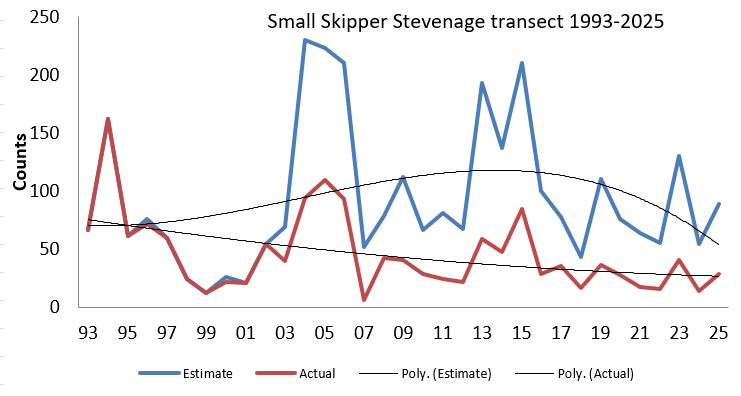
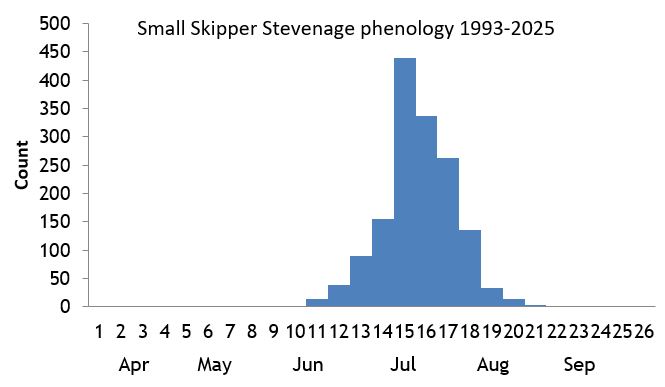
Knebworth Park transect 1996-2010 and 2017-2025
Like the Essex Skipper this species has suffered a huge decline since 2005 when 451 were counted. In 2010 only two were recorded and 72 in 2017-2022 altogether. Habitat loss or change is likely to be one of the main reasons although warm and dry weather in the spring or early summer may have had an impact on abundance as indicated for the Stevenage transect. The butterfly continued to struggle after 2022.

Knebworth Woods transect 2017-2025
Uncommon and declining numbers since 2020. All were seen in grassy areas like Burleigh Meadow and Norton Green Common.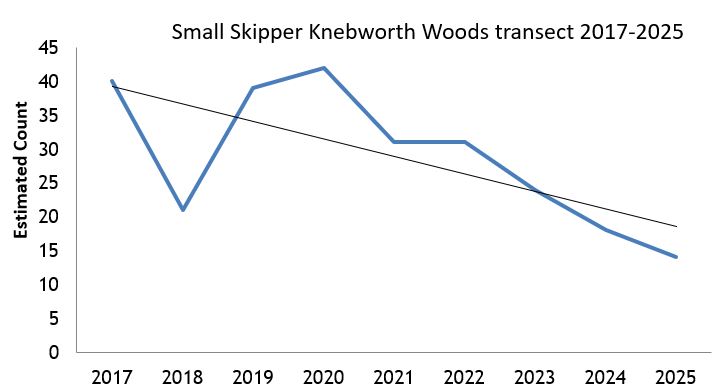
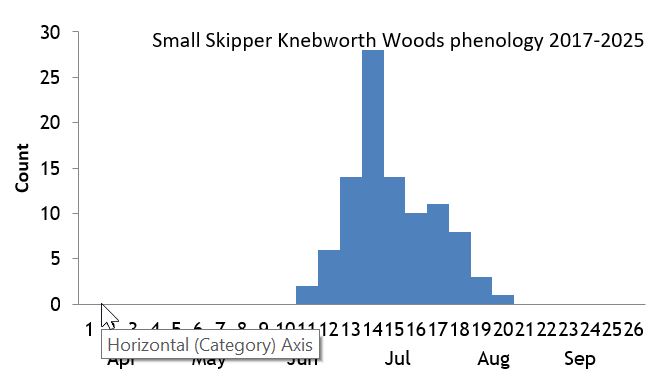
Pryor's Wood transect 2000-2022
Several were seen in most years in the 2000s with a best count of seven on 24 July 2008 but between 2008 and 2019 only two known records were submitted, on 9 August 2015 and 22 July 2019 (three specimens) although there was a possible example in 2017. However, there were four reports received for 2020 including a total of seven specimens on 26 June but no records were submitted in 2021 and 2022.Life History
Earliest date: 6 June 2015 at GlaxoSmithKline, Stevenage
Latest date: 22 August at Fairlands Valley Park in 2012 and
at Norton Green Common in 2015
There is only one generation of this butterfly with the vast majority on the wing in July although some will
linger beyond the middle of August. Several eggs are laid in the sheaths of grasses. I saw a female egg-laying on Yorkshire Fog at Norton Green Common
on 16 July 2019 at 6.15 pm. The larvae on emerging construct a silk cocoon still within the sheath
of grass and hibernate in this chamber. In the following spring the larvae emerge from the cocoons and feed on the grass blades. When fully grown,
a tent is spun using the grass blades within which a pupa is formed.
Behaviour/Observation notes
Because of the confusion between this species and the Essex Skipper the best time to positively identify which one is either in cloudy weather or in the evening when the butterflies are less active. Early in the morning is also another good time to look for these skippers as they are often found feeding on flower-heads (Riley). Approaching them at rest or feeding should then be far easier to get close-up views of the antennae, a distinguishing feature. Differences are explained in the account for the Essex Skipper.
Variations/Aberrations
Varieties or aberrations of the Small Skipper are rare. A specimen with its ground colour very pale white is ab. pallida was spotted in Scotland
in 2010.
Find out more on the UK Butterflies website
References
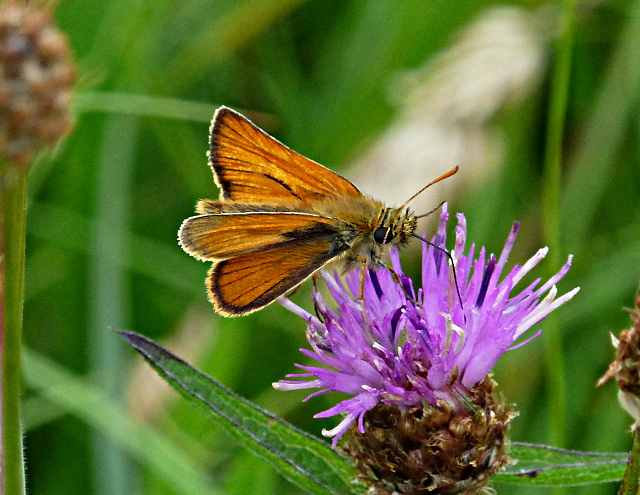
Burleigh Meadow 13 Jul 2016 (m)
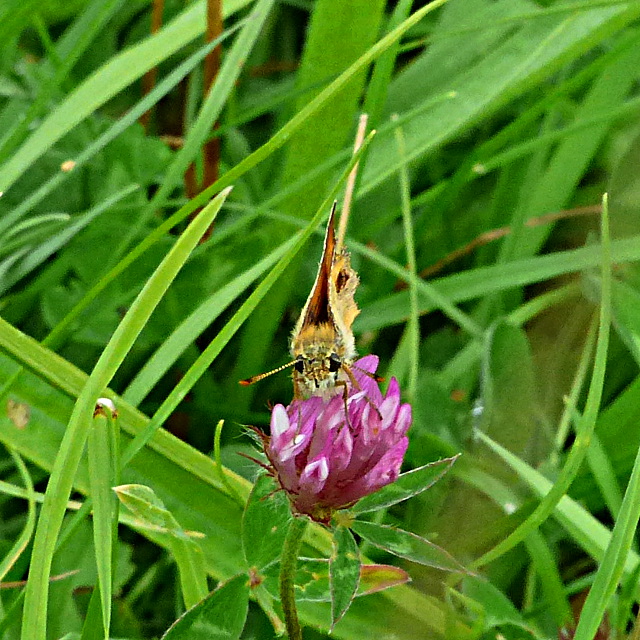
Watery Grove 13 Jul 2016
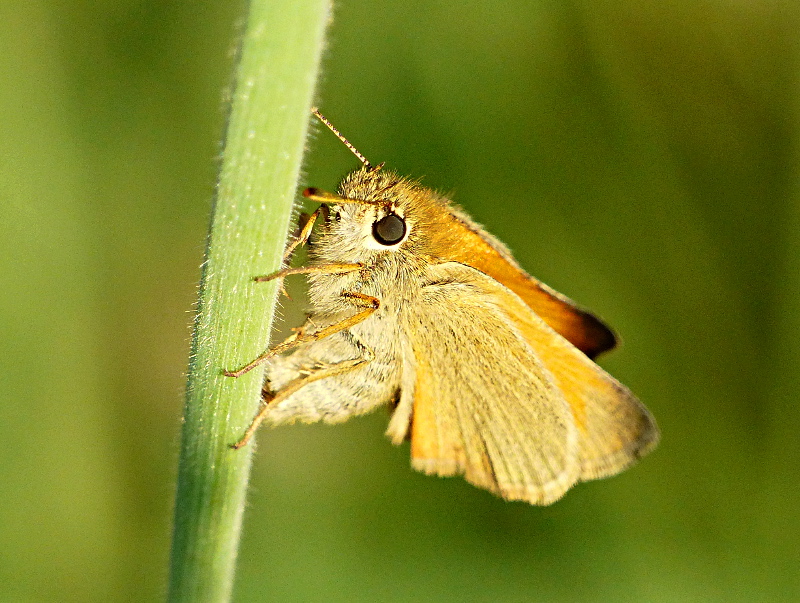
Egg-laying Norton Green Common 16 Jul 2019
